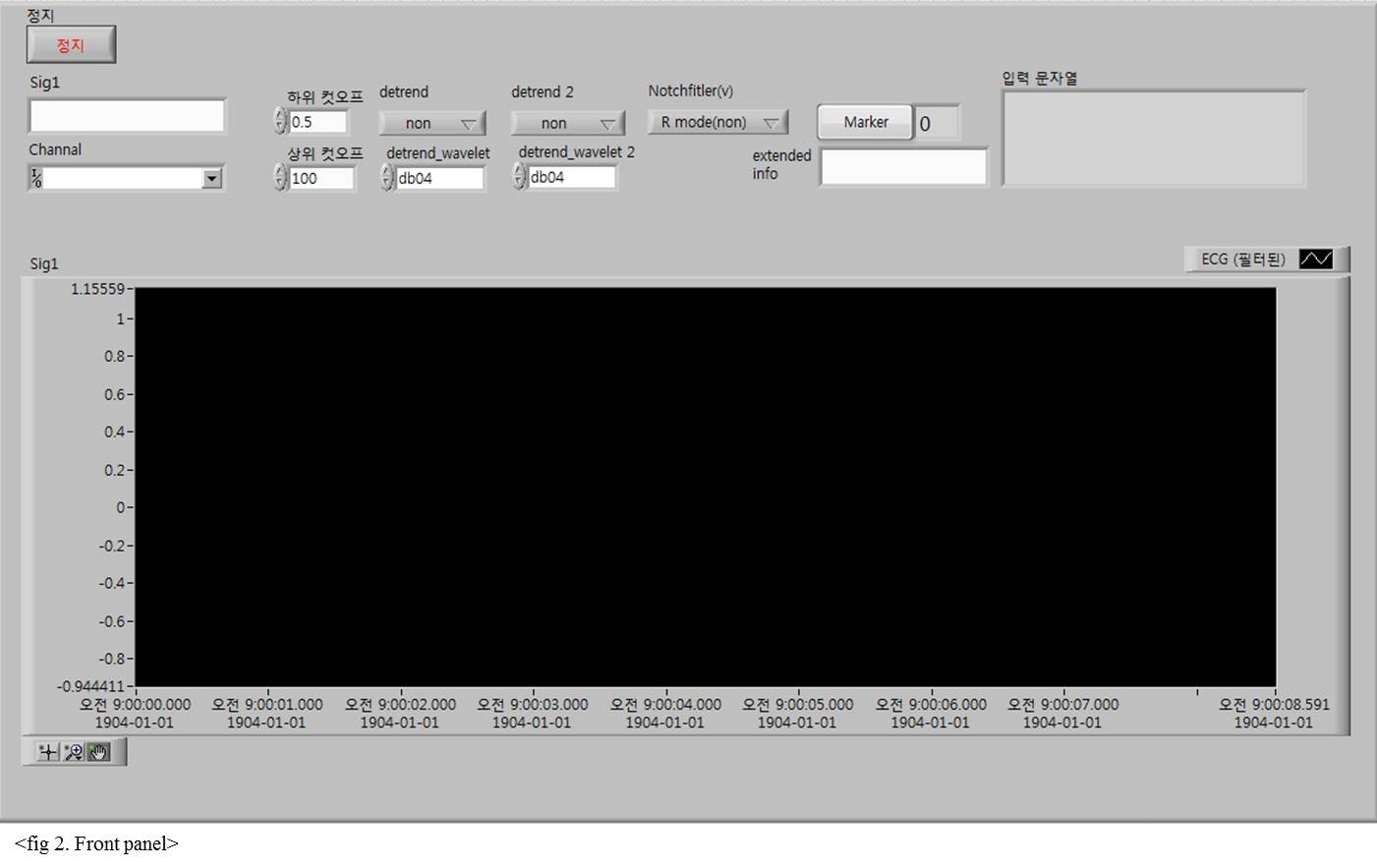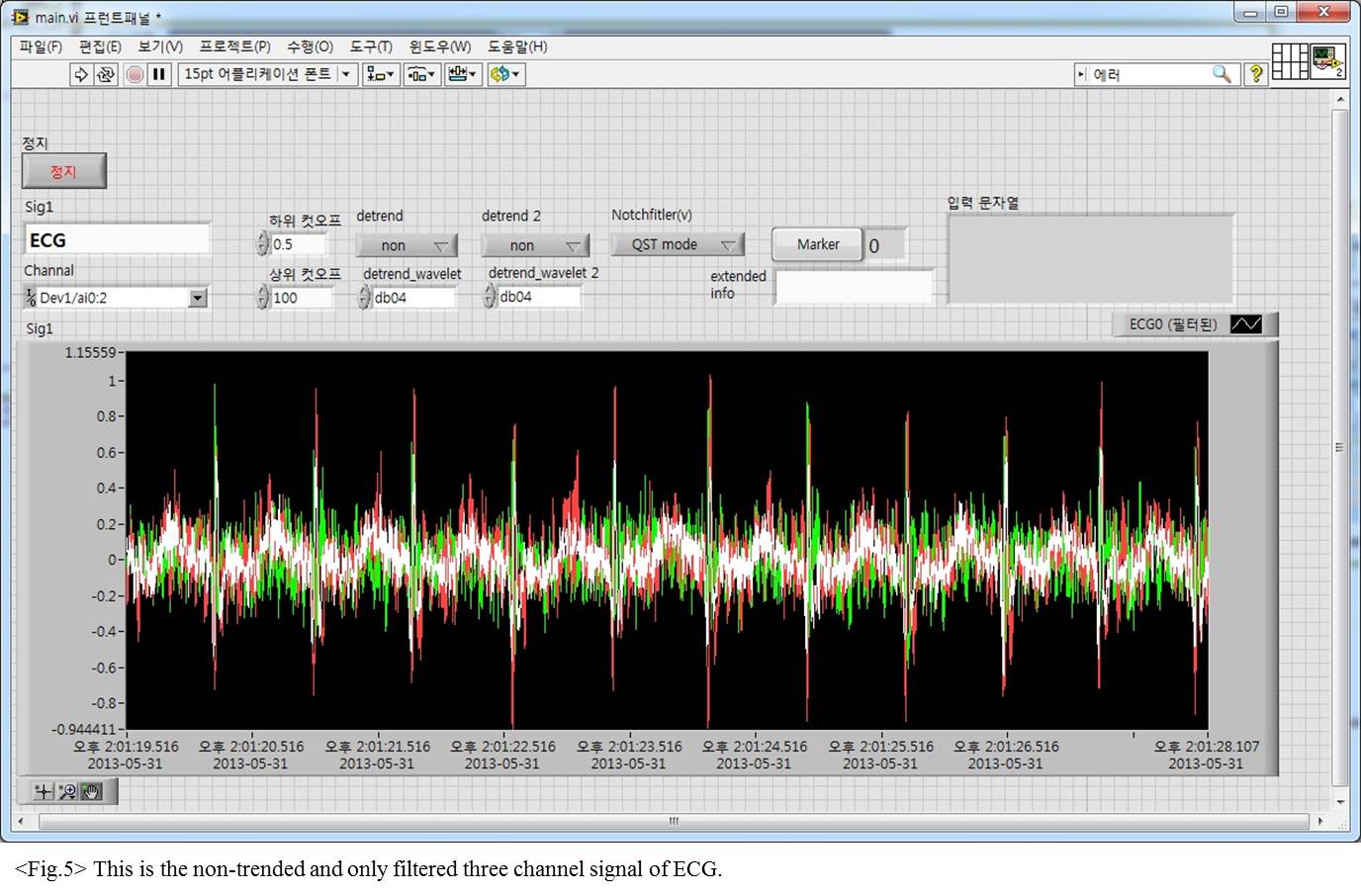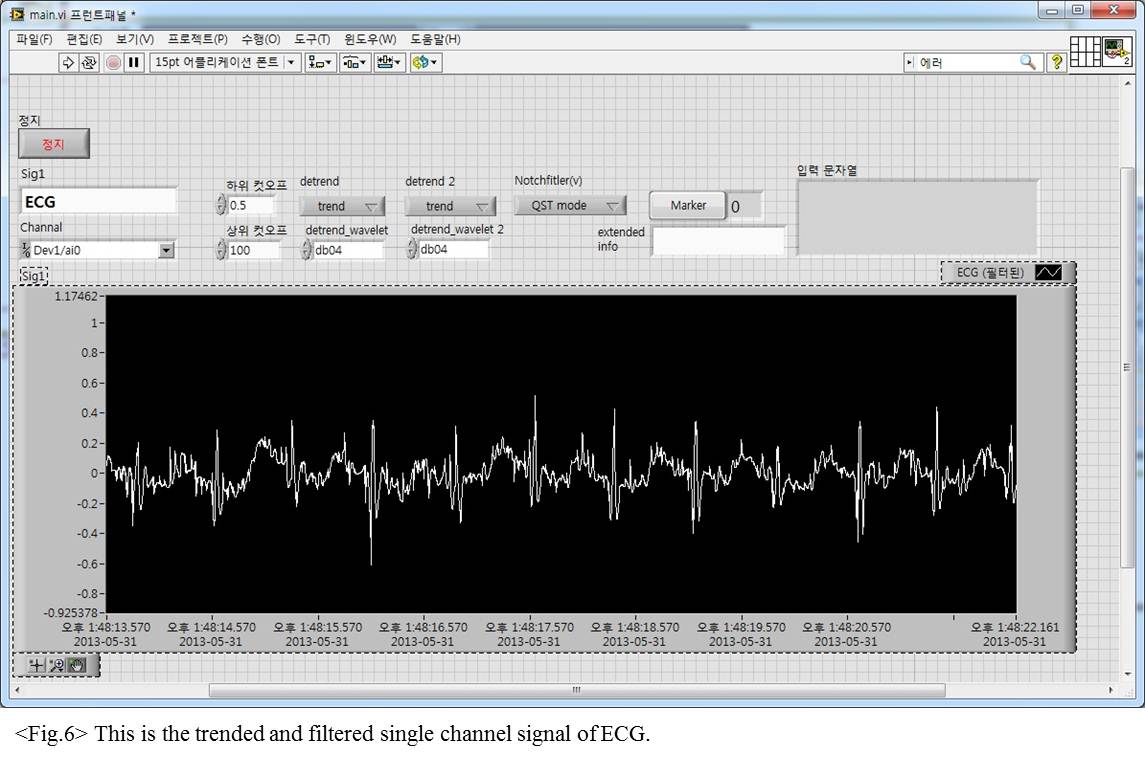- Document History
- Subscribe to RSS Feed
- Mark as New
- Mark as Read
- Bookmark
- Subscribe
- Printer Friendly Page
- Report to a Moderator
- Subscribe to RSS Feed
- Mark as New
- Mark as Read
- Bookmark
- Subscribe
- Printer Friendly Page
- Report to a Moderator
Contact Information
University: Korea University
Team Members (with year of graduation): Seunghan Seo (2014), Byunghoon Ahn (2015)
Faculty Advisers: Prof. Gyutae Kim
Email Address: ssht0622@gmail.com, bhahn221@gmail.com
Submission Language Korean and English
Project Information
Title : Real-time Body signal Wavelet Analyzer with Minimal Hardware
Description: This project provides an economic and simple solution for measurement of real time Body signal and analysis of Wavelet transform without a complex circuit nor profound computer programming knowledge.
Products
National Instruments LabVIEW 2012
National Instruments ELVIS II
LabVIEW Advanced Signal Processing Toolkit
PC
1$ Wires with ECG Patches.
The Challenge
1. Prices of sensor and the sensor exclusive cables are prohibitive.
2. There are variegated applications of ECG/EEG/EMG/EKG signals in fields of Material Science, Electrical Engineering, Apparel Studies and Health Care. However, there are countless difficulties in circuit design and programming while trying to acquire data and applying it to related fields, and the prices it take to solve or reduce such difficulties are too expensive.
3. Dearth of software taking advantage of the National Instrument's measurement specialized software and hardware tools, with high speed and accuracy.
4. Ways to measure multi-channel signals without complex circuit boards and sensors are needed.
So, this project provides an economic and simple solution for measurement of real time Body signal and analysis of Wavelet transform without a complex circuit nor profound computer programming knowledge.
The Solution

1. Virtual Hardware
Most hardware devices measuring human body signal consists of amplifiers and various filters. However, we have made a virtual hardware using the toolkits provided by the LabVIEW program.
By changing the low and high cut-off frequency in the Software, You can choose measurement mode. such as EEG/ ECG / EMG /EKG most of body electric signals.
2. Wavelet Analysis
Wavelet Analysis has been made in order to complement the downturns of the traditional Fourier analysis. We have used the provided Sub VI’s in the LabVIEW program to implement the needed analysis tool. The signal from the virtual hardware, first, goes through the 1st Wavelet Detrend and then the 2nd Wavelet Detrend and then 2nd Notch Filter. Usually, the Detrend method is used to take out the baseline wandering from the signal, but we have, instead, used the Trend method to reduce the white noise, by taking data from the short time interval. 2nd Notch Filter is to reduce the noise: unwanted electrical signals from the muscles,
3. Data Plot and Save
Every moment the button for the markers is pressed, it will activate the latch and it activates the feedback counter for the numbering and this number will be added with any other string data using format into string function. We used the format into file function to consolidate various data: current time value of the signal and markers. We used this particular function over any other, since this function was an easiest tool to use for the consolidation of various data types, string and double.
Explain the benefits using LabVIEW and NI tools
1. Hardware is not needed and most of the process, which used to be done by hardware, can be implemented software tool kits. This makes it easy to modify the measure prior NI devices.
2. Measurement is simple, real-time and accurate, and additional wires can be added with fairly low price and complexity.
3. Due to the use of G-Programming, coding of the measurement can be completed in straightforward manner and modified easily. This makes it easy for the non-computer major researchers and learners to comprehend the program.
4. With purchase of the additional toolkits, Wavelet analysis using the adaptive filters and the complex FIR Filter (Finite Impulse Response Filter) can be easily and quickly implemented.
<Insert image(s) of project with captions.>




<Insert video here.>
<Attach VI code (optional).>

Level of completion (beta, alpha, or fully functional)
Beta. v1.2
Fairly accurate measurement of the body signal has been implemented and partial multi-channel measurement (multi-channel filtering has been implemented, but multi-channel wavelet analysis) has been made and open for further revision and extension.
Time to build
5 weeks in total.
- Week1 : Study of LabVIEW basic theory.
- Week2 : Study of Hardware of ECG/EEG/EMG/EKG sensors and planning of software structure.
- Week3 : Building of software based ECG
- Week4 : Building of software based ECG
- Week5 : Software completion, report writing and movie making.
<Additional revisions that could be made>
By linking this measurement tool with other mobile devices, it can be made possible to check ECG data from such devices. By taking it one step further, we can make a web based tool to dynamically check the measured data. Multi-channel wavelet analysis is yet to be completed, so, in further revisions, this can be implemented to give better output. Also, we can add a RF circuit to the board to make mobile measurement possible.
Attach Poster (30 in. x 38 in.) and LabVIEW Code
<Include captions for all graphics material. Type your photo or graphic caption underneath each graphic using this 10 pt Times New Roman font. Embed all graphics. Remember—you must provide individual electronic files for each graphic you include in your paper. Place photos in text after first reference—you must include a reference to all graphics in the text. Include screen captures if you use National Instruments software products. Screen captures must have a minimum resolution of 72 dpi at 100 percent. All other graphics must have a minimum resolution of 300 dpi.>

Nominate Your Professor (optional)
고려대학교 공과대학 전기전자전파공학부 김규태 교수님
고려대학교 공과대학 전기전자전파공학부 윤태웅 교수님
- Mark as Read
- Mark as New
- Bookmark
- Permalink
- Report to a Moderator
Excellent job!
- Mark as Read
- Mark as New
- Bookmark
- Permalink
- Report to a Moderator
GJ!!
- Mark as Read
- Mark as New
- Bookmark
- Permalink
- Report to a Moderator
great project I am moved by its emerous effort
- Mark as Read
- Mark as New
- Bookmark
- Permalink
- Report to a Moderator
방법이 있습니다. 아주 좋은 조언
